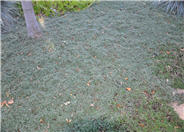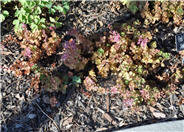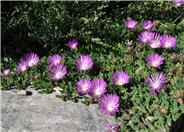
Common name:Woolly Thyme
Botanical name:Thymus lanuginosus
Woolly Thyme is a perennial groundcover growing in a low mat, typically under 2 inches, but spreading 16 inches or more. Foliage is fuzzy and gray-green during the summer months, and tinged with a lovely burgundy hue in the fall and winter. An evergreen thyme, it makes a wonderful groundcover, even an alternative to turf, in low traffic areas. And as it tolerates some foot traffic, its wonderful between pavers and along pathways. It has a pink summer bloom, though it rarely flowers; the lovely fall color fills the void.

Common name:Dragons Blood Sedum
Botanical name:Sedum spurium 'Coccinium'
Dragons Blood is an old sedum variety, but it still shows up in nurseries, and for good cause. Foliage first emerges a bright red, and mellows to a lovely green with red margins during the summer months. Leaves become brilliantly red with cool autumn temperatures. Deep rosy-red flowers contrast with the green leaves in early summer. Use in rockgardens, along paths, at the edges of summer borders, or in parkstrips. Grows about 3 inches tall and spreads up to 24 inches wide.

Common name:Purple Ice Plant
Botanical name:Delosperma cooperi
This is another fine South African introduction valued for its shimmering fuchsia purple daisies that keep coming all summer. A vigorous spreader, it forms a dense mat of succulent, linear green, succulent leaves. Succulent fleshy green foliage is sometimes tinged with purple in winter. Foliage is covered with transparent flakes that somewhat resemble tiny pieces of ice, hence the common name. Plants are evergreen in warm winter climates, but at best are usually only semi-evergreen here. Grows 3 inches tall and 18 inches wide.
| Designer: Xeriscape Design | Color Hill 3 |
Photographer: GardenSoft |
Water Saving Tip:
Change spray sprinklers to low-flow bubbler or drip systems. Shrubs and trees are ideal candidates for this type of irrigation because the water is applied directly to the root zones.
